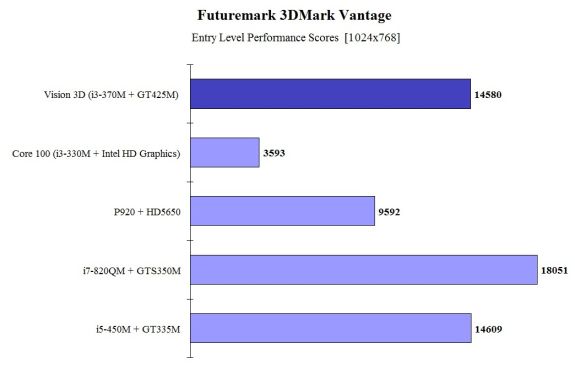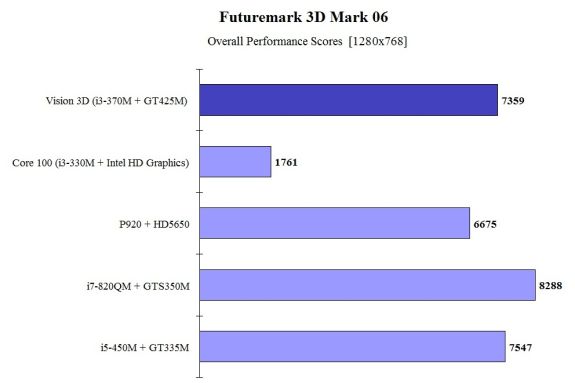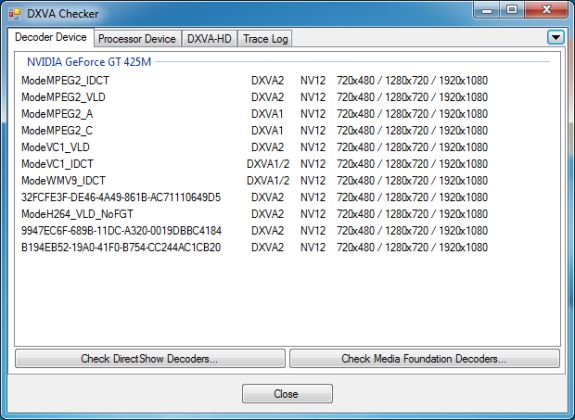ASRock's High-End Vision 3D HTPC Reviewed
by Ganesh T S on October 3, 2010 10:20 AM ESTThe GF108 Fermi lineup was announced by nVidia at the 2010 IFA in the first week of September. We already covered their announcement in a previous piece along with the details of the architecture. I happen to be the first editor at AnandTech to get hold of the actual silicon in a system, and the full responsibility of putting it through the paces fell on me. Though I happen to be more of a HTPC person, I did manage to run a few of the gaming benchmarks developed by Jarred. I have been playing around with various beta driver releases from nVidia ever since I got hold of the engineering sample, but the results presented in this piece are all obtained with MXM driver version 260.66. Before we get to the gaming performance, let us take a look at some of the synthetic benchmarks related to the GPU in the Vision 3D.
The GeForce 425M comes out with surprisingly better performance than the Mobility Radeon 5650. Though the effective memory bandwidth in the 425M (25.6 GBps) is lesser than that available in the 335M (34.1 GBps), the architectural improvements seem to have delivered very similar scores in our two synthetic benchmarks. But, do these improvements show benefits in actual gaming performance? We will see that in the next section.
Our coverage of the 400M series indicated that the number of shaders in almost all the members of the GF108 series is constant at 96. They all have a DDR3 memory interface running at 800 MHz. The processor clock is locked at 2x the graphics clock for all the models. While the default 425M graphics clock frequency is 560 MHz, we could easily overclock it to 650 MHz (435M default frequency) using the nTune program available as part of the nVidia system tools suite. The GPU is very overclocking friendly, and we were even able to ramp up the memory clocks to the rumoured GT 430 specifications without encountering any issues.
The GF108 brings the latest and greatest in PureVideo to the consumer. Based on VP4, it supports hardware accelerated decode of almost all video codecs except Real Media and the On2 codecs. We have already seen the DXVA status of a VP4 enabled device in the GeForce G210 in a previous article. The DXVA Checker report for the 425M is provided below, and there is nothing unexpected in it.













51 Comments
View All Comments
strolfey - Monday, October 4, 2010 - link
Thanks a bunch! Based on this, there's no major hangups so I'll be looking to get one as soon as it's available from newegg.cjs150 - Tuesday, October 5, 2010 - link
Bit like the Apple TV article, we are moving closer to the ideal living room HTPC but not there yet.A decent SSD rather than a HD would be better, less noise, reliability not an issue, less heat.
Noise is the issue for me. This is improving (and would be less noisy than my current cable box) but still not perfect (total silence would be perfect but impractical).
I do wonder whether an optical drive is really necessary. Seems to me that there may be 2 HTPC markets. One for a streaming device that can play games and another where the device is also the sole Blue-ray/DVD player on an AV system.
I would be happy to ditch the optical drive for a TV tuner. Even more so if it could replace the cable box
blacksun1234 - Wednesday, October 6, 2010 - link
Dear Ganesh,Is its BD playback video quality better than consumer BD 3D player?
ganeshts - Wednesday, October 6, 2010 - link
I didn't do a side by side comparison, but I would believe that you have lot more tweaks available at your disposal on the HTPC to do some post processing if you desire (compared to the options in a consumer BD 3D player).The only advantage of a consumer BD player I can foresee is the ease of use factor. HTPCs are inherently not designed to cater to the lowest common denominator yet. (Yes, we have Win7MC + PDVD / ArcSoft integration, but you still need to do some configuration like AutoStart / Start Maximized / configuration of 3D display etc. etc. to make sure it acts like a consumer BD 3D player).
SirMeili - Wednesday, October 6, 2010 - link
With my current HTPC, I can have distinct On and off Codes. so my question is this:You said you can wake the HTPC via the remote, but can you
1) put it to sleep with the remote, and
2) Turn the computer on with the remote (from an off state)
3) program additional codes for the IR Receiver (for instance, I have a button on my universal for alt-f4)
Neither are ultimately important, but I like my setup as it is now (especially since I can train specific on and off codes for my IR Receiver for the HP)
ganeshts - Wednesday, October 6, 2010 - link
1 and 2 are definitely possible ( 2, when AC power cord is still connected, but you already knew that :) )As for 3, I will ask ASRock. I haven't personally tried out.
The Jedi - Tuesday, October 12, 2010 - link
If this were an Asus brand product I might find it more attractive, but I think ASRock has issues with its reputation. I mean they make some innovative and low cost mobo's, but from reading around they seem to have quality control issues. Last time I visited their website they had imperfect English so I think I'll just stay away.mutarasector - Monday, November 29, 2010 - link
Can't wait to see a Llano powered version of this thing. I believe one might see a mini based on it by the 'Fruity computer Co.' in the not too distant future.borekb - Tuesday, February 1, 2011 - link
On these screen-less HTPC devices, how do you display things like MP3 or volume information while you're playing musing and the TV is turned off? I'm thinking about attaching a digital picture frame but would that be possible to output the signal to both HDMI (-> A/V Receiver -> TV) and to the frame? (I don't own any digital picture frame at the moment so I'm not sure what would be required on that front.)mpogr - Thursday, June 2, 2011 - link
Got one of these. They sell them here in Australia without memory and HDD, purchased both from the same store, the total price was ~940AUD (should be ~970-980 USD now)..Assembly was quite easy and all was working fine at first. Installed Windows 7 Ultimate 64 bits, SageTV client and PowerDVD 11 (planned primary use: TV and, occasionally, 3D Blu Ray playback). Because of TV being used by the children, the computer was always on (but not always playing back media). The unit died after ~5 days. I wasn't at home when this happened, but it just powered itself off. After that, upon disconnecting and reconnecting power, it came on and then off straight away. Resetting CMOS and pulling the BIOS battery out helped a bit, so now it doesn't power itself off after reconnecting the mains. The blower spins and the power led is lit, but no video output and no HDD activity. Disconnecing HDD and ODD didn't help.
So it's just dead. It can be the unit itself or the memory, as I don't have any spare SODIMMs to test. About to send the unit back to the retailer for investigation.